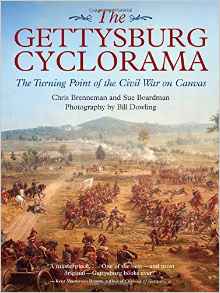The Gettysburg Cyclorama: The Turning Point of the Civil War on Canvas by Chris Brenneman, Sue Boardman, and Bill Dowling. Savas Beatie, 2015. Cloth, ISBN: 978-1611212648. $34.95.
 This is not just another book about the battle of Gettysburg. Licensed Battlefield Guides Chris Brenneman and Sue Boardman tirelessly researched the history of the most famous American cyclorama, offering the most comprehensive guide to the painting ever published. This book serves as a “myth-buster”, a historical reference, and a key to the newly restored Cyclorama at the Gettysburg National Military Park.
This is not just another book about the battle of Gettysburg. Licensed Battlefield Guides Chris Brenneman and Sue Boardman tirelessly researched the history of the most famous American cyclorama, offering the most comprehensive guide to the painting ever published. This book serves as a “myth-buster”, a historical reference, and a key to the newly restored Cyclorama at the Gettysburg National Military Park.
In 2012 Brenneman and Boardman, along with Licensed Battlefield Guide and photographer Bill Dowling, painstakingly recreated the original photographs taken in 1882 by William H. Tipton and used by the artist, Paul Philippoteaux, as references for the cyclorama. The authors are uniquely positioned to write this book because of their deep involvement in the painting’s restoration, which began in 2004.
The book is not merely a narrative of the restoration process, but rather a guide to the history of the original cycloramas produced by Philippoteaux. The authors mined manuscript collections and newspapers to capture the excitement that Americans felt about this exhibition. They also clear up some myths along the way. For example, they are certain that the original cyclorama was not on hand for the Chicago World’s Fair, as previously believed, but that a reproduction was used in its place. The early chapters read a bit like a detective story as the authors track the movements of the multiple copies produced by Philippoteaux and the countless counterfeits painted by pretenders.
The authors are conscious that this work of art was just that—a cultural production not intended to represent the “truth” of the battle, but to entertain the American public. They illuminate how war memory was used as popular entertainment in the decades following the Civil War, and demonstrate that real money could be made by selling wartime nostalgia: the original shareholders of Philippoteaux’s Chicago version of the cyclorama, for example, received roughly $25,000 per year for the first ten years of its life! While the painting now hangs inside the Gettysburg National Military Park Visitor’s Center, the cyclorama is not solely a source to help understand the battle on July 3. Instead, it serves as a window into the cultural demands of the postwar public and their need for tangible remembrances of the conflict.
The real heart of the book is the viewing key. The final ten chapters guide the reader through ten photographs encompassing the entirety of the cyclorama, as one might view it in its current setup at Gettysburg. The authors meticulously mark and describe every significant individual, unit, building, and geographical landmark. They point out anachronisms, detail the decisions made by Philippoteaux to include certain people and units, and illustrate that while the painting was meant to be allegorical, it captures a moment the time that many still argue was the High Water Mark of the Confederacy.
Tyler Sperrazza is Ph.D. Candidate in History and African American Studies at The Pennsylvania State University. His research focuses on theater and popular culture during the Civil War and Reconstruction.
